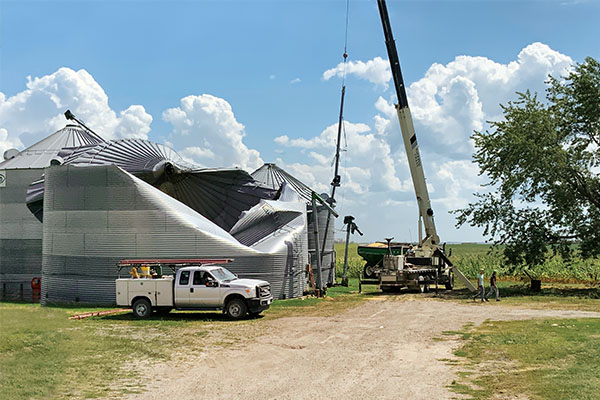PADD 2 plans for residential surge this winter
Usually, at this time of year, crop drying demand dominates the attention of propane retailers in the Midwest. However, a manageable harvest and concerns about the trajectory of the COVID-19 pandemic have shifted the region’s focus toward the possibility of a heavy residential load during the coldest part of the year.

A crane operator prepares to remove grain bins damaged by the derecho near the town of Van Horne in east-central Iowa. Photo by Jay Christie
This year’s corn harvest has progressed at a steadier pace than last year’s due to timelier planting schedules and drier conditions.
“The crop in 2020 was planted very timely, which gives the opportunity to have a normal growing season with normal heat, and really you’re banking on rainfall and weather being the biggest variable,” says Michael Newland, director of agriculture business development at the Propane Education & Research Council, during a supply webinar hosted by the National Propane Gas Association in early September.
Select states, like Iowa, have already seen significant impacts from weather events. A derecho, or powerful windstorm, that swept through Iowa in August destroyed at least 200 million bushels of corn in the state. Additional bushels have been lost due to extended drought conditions in some areas. For these reasons, crop drying has been a calmer, more gradual process this year, says Deb Grooms, CEO of the Iowa Propane Gas Association (IPGA).
IPGA is still encouraging farmers and homeowners to fill early, especially as residents continue to stay home due to the pandemic, she says.
For Derek Dalling, executive director of the Michigan and Ohio propane gas associations, the uncertain trajectory of the COVID-19 pandemic presents the biggest challenge to marketers in his territory.
An “eye-opening” spring serving customers under stay-at-home orders has prompted propane retailers in Michigan and Ohio to prepare for the possibility of “round two” during much colder weather, says Dalling.
“Now with kids at home, people working from home, that could really change the dynamics of what it’s going to be like to have the supply to meet demand in the winter,” he says.
Recent infrastructure investments in the region by Crestwood and NGL, as well as a fully operational Line 5 pipeline, will help retailers rise to the occasion, says Dalling: “It’s a win-win for the region to have these investments being made by trusted wholesalers – absolutely more opportunities for our retailers to find the product they need at the highest demand times.”
App tracks wait times at terminals
The National Propane Gas Association (NPGA) is working to increase the flow of information and propane with its Propane Logistics Analysis Network (PLAN) app, a crowdsourced online tool that shows wait times at supply points across the country.
PLAN went live in September 2019 with the goal of helping the industry maximize hours of service and make sound choices on where to obtain product. One year later, the app has about 4,600 users, 8,600 sessions and 1,200 entries, says Eric Sears of NPGA.
“We’re going to see the use of this app increase over the next couple of months,” adds Sears, noting how Wisconsin has seen the most use of the app since the launch.
PLAN allows users, especially drivers, dispatchers, terminal managers and wholesalers,
to report their wait times by searching – by state or nearby supply points – from about 410 terminals nationwide. Users can also report supply point closures and edit terminal location information.
NPGA is encouraging industry members to share the app. Users can visit plan.npga.org or download the NPGAction app from the Apple App Store or the Google Play Store.
















